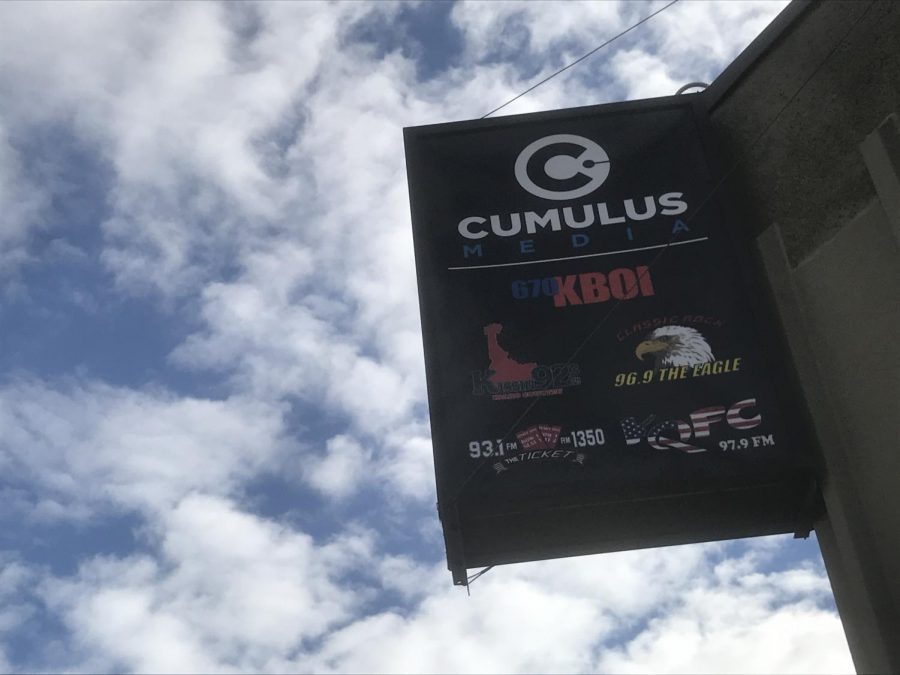The Rise of Online Music Streaming: Leaving Broadcast in the Past?
Photo Credit: Lauren Lafrades
The Cumulus office in downtown Boise that broadcasts local radio stations.
March 14, 2019
Since its introduction in 1920, radio has been leading source of entertainment, music, and news.
It’s widespread reach led radio to be a trendsetter in the types of music that gained popularity, the new stories that received the most coverage, and brought iconic radio hosts into celebrity status.
With the shifting field of technology, tablets and smartphones have become our new, portable entertainment consuls. Streaming services like Pandora, Spotify, and Apple Music capitalize on the growing amount of users of these technologies and market a form of music streaming that has skyrocketed in popularity. Unlike broadcast radio, streaming services provide a more personalized approach to music choice and have nearly limitless options to suit every taste. This growing amount of easily accessible material raises a question; Is radio seeing it’s beginning of the end?
Forrest Smithkors, The operations manager for Cumulus Boise and oversees programming for five local radio stations, believes this isn’t the case.
Concerning the question of if listenership of radio stations has decreased since music streaming services became popularized, Smithkors finds the opposite to be true. He explains, “This is a common misconception. Music streaming changed the album sales side of the music industry while radio remains strong.”
AM/FM radio remains the leading source of music and entertainment. A Nielsen Company report in 2018 calculated that when comparing gross minutes of listening time spent, Radio dominates streaming audio by a factor of 14 to 1 in an average week. The study also found that radio continues to reach more people weekly than any other medium in the U.S., including TV, smartphone apps/ websites, and smartphone video. It is estimated that globally, 3 billion people listen to radio per week.
Smithkors also explains how radio stations can take advantage of markets opened up by online music streaming. “We’re not competing with streaming but we are adjusting with listening technology. All of our radio stations and shows have free apps for you to listen on your phone, laptop, or tablet,” he justifies.
Radio stations are also taking advantage of the growing popularity of online podcasts. Similar to radio shows, podcasts offer a pre-recorded form of a talk show that has gained more listeners through the normalization of online streaming. “ Our radio stations also share their own podcasts on a variety of different subjects. It doesn’t mean we’re doing less radio, we’re offering our services in a platform of different ways,” Smithkors expands.
What Smithkors finds to be most true is that people still listen to local radio because it’s an integral part of connecting the community. Local radio station’s target audience is the community they are in. They center stories and coverage on events that most directly affect their listeners. They provide local opportunities that can’t be replaced by online services. “Our stations keep Idahoans up with local news, traffic, weather, and feature interviews and call-ins with local residents […] You might have a great classic rock playlist built, but that can’t get you tickets to see Bob Seger in Nampa, backstage passes to meet cheap trick at the Boise open, or Boise State football tickets for you and your friends.” Smithkors confirms.
In the future, radio will likely remain highly popular and influential. The rise of streaming services provides even more platforms for material that listeners can enjoy, and the new technology can work in conjunction with broadcast radio to benefit consumers. Smithkors concurs, “ Just because a new taco truck showed up in town doesn’t mean I’m going to eat pizza any less, it just means I’m going to do both. […] Just because I love watching Game of Thrones doesn’t mean I’m not going to get in line to see the new Avengers movie. I’ll do both. Pizza and tacos. Superheroes and dragons.”



